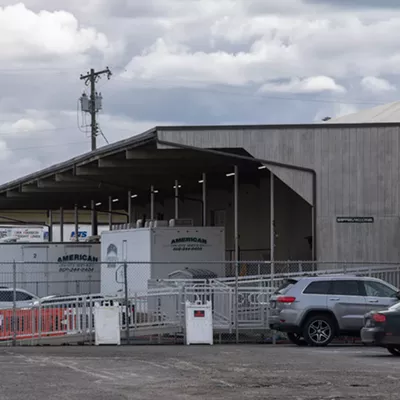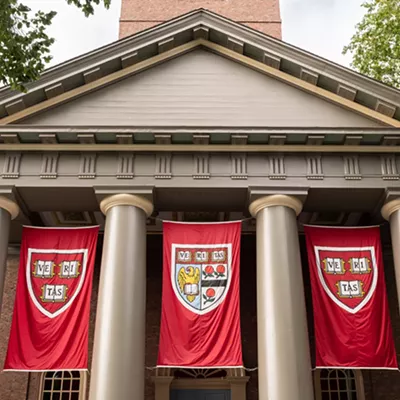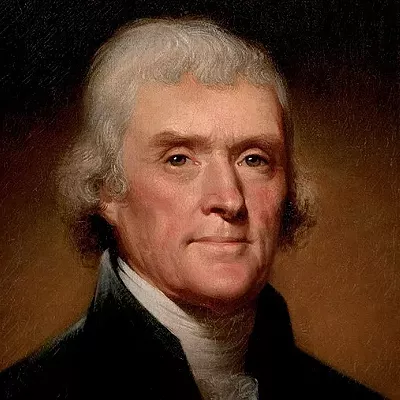Energy isn't forever. Images of burning oil fields across Iraq -- siphoned through cameras for American eyes -- increasing gas prices, and strings of black- and brownouts symbolize the United States' growing but reluctant awareness that traditional sources of energy are not cheap. They're not renewable, either.
As a result, the U.S. government is pouring millions into alternative energy research (such as wind, solar, biomass and hydro). Yet support for nuclear energy is growing in Washington, D.C.: the nuclear industry has more funding for future projects than at any time since the Cold War. Perhaps because nuclear energy is the source of 20 percent of the U.S. electricity supply, many politicians have decided to join forces with the nuclear industry, promoting it as the best alternative to traditional energy sources. Idaho Sen. Larry Craig is one of them.
"Senator Craig has followed the development of nuclear energy in this country throughout his career," says Will Hart, Craig's spokesman. "He believes that nuclear energy is one of the cleanest, most reliable and cost-effective sources of energy available to this country, both currently and for the future."
Craig, with the support of the Natural Resources Committee Chairman, Pete Domenici (R-N.M.), announced a proposal for the development of a $1 billion nuclear reactor in southwest Idaho last spring. That proposal is now a part of the current Energy Appropriations bill, which is being haggled over behind closed doors in conference committee. Both Sens. Craig and Domenici are part of the private sessions, mainly involving GOP lawmakers, designed to work through differences between the Senate and House versions of the bill. Already stymied with hundreds of amendments, the bill falls just short of Iraq as D.C.'s biggest quagmire. It's been held up partly by clashes between powerful corporate and environmental groups. The bill includes about $35 billion for research and development, which consists of $2 billion for clean coal, $1.8 billion for the President's hydrogen fuel-cell initiative and $1.7 billion for nuclear energy.
Sen. Craig's nuclear reactor would be built at the Idaho National Engineering and Environmental Laboratory (INEEL), just outside Pocatello, Idaho. An 890-square-mile government reservation, INEEL was established in 1949 as the National Reactor Testing Station. INEEL irradiates materials for the Navy and built the Navy's first prototype nuclear propulsion plant.
"There are a total of 52 nuclear reactors in Idaho, which is a higher concentration of them than anywhere else in the world," says Jeremy Maxand, executive director for the Snake River Alliance, Idaho's nuclear watchdog organization. "[Idaho is] where the nuclear Navy developed. We not only export potatoes, we also export nuclear power technology."
Of those 52 reactors, nine remain active or have not yet been fully decommissioned and decontaminated, according to the Department of Energy. Maxand says pouring a billion dollars into building another nuclear reactor in Idaho, before cleaning up the current nuclear waste, will endanger the environment further.
Hart, Sen. Craig's spokesman, disagrees: "This country is in its sixth decade of building and operating nuclear plants," he says. "Nuclear energy has been and will continue to be a cornerstone of our energy security."
Clean or Dirty? -- While the nuclear industry claims nuclear energy is clean, emitting no air pollutants, Maxand says nuclear waste has created so many environmental disasters that it's difficult to know the extent to which the waste has harmed the environment and people.
"The [nuclear] industry is making a lot of promises," says Maxand. "They are tossing around a lot of terms to convince the public for support and some of those terms are, 'clean, inherently safe,' and 'nuclear energy is the only viable source of energy to transfer to hydrogen-based economy.' Part of the argument is that it will produce hydrogen to power cars."
The truth, Maxand says, is far dirtier. "The spent fuel that comes out of a reactor is some of the most dangerous and difficult-to-handle waste on the planet, and it remains like that for a very, very long time. No matter what they say about inherent safety, which is misleading, these reactors are catastrophic accidents waiting to happen."
In Idaho's 52 nuclear reactors, there have been 27 "meltdowns," in which there was structural damage to the reactor. In 1961, the first fatal nuclear accident in Idaho killed three plant workers and sent a nuclear cloud into the Snake River Valley that lingered for 30 days.
"There are 750,000 barrels, boxes and crates of plutonium contaminated wastes that is currently sitting in unlined pits and trenches 500 feet above North America's second-largest aquifer," Maxand says, referring to the nuclear waste in Idaho. "It's the largest concentrated burial ground of nuclear waste in the country. It's infamous."
Maxand claims that environmental risks are just one of the dangers of building more nuclear reactors. He says building new nuclear reactors, even if weapons aren't being manufactured there, adds to nuclear proliferation issues, which is contradictory to the United States' post-Cold War stance. And it doesn't do any favors for homeland security. He says an investigation of Indian Point, a commercial power reactor near Manhattan, revealed that there is virtually no security around the reactor or the spent-fuel pools. Maxand says that in mock exercises, investigators were able to break into the plant.
"If someone were to get in there and damage the spent-fuel pools by draining them, you'd have a bloom of radioactive airborne material that would head in whatever direction the wind is going," Maxand says.
"Nuclear power plants have a safety record that is the envy of other industries," argues Hart, Craig's spokesman. "In implementing the reactor project, the Department of Energy will evaluate what is needed in terms of regulatory compliance, including what is needed with respect to the National Environmental Policy Act. The cost of this regulatory compliance is included within the funds that Congress is providing for the project."
The nuclear reactor is slated for completion around 2010. But Maxand says that even though the nuclear reactor at INEEL is built into the current Energy Appropriations bill, it isn't a done deal.
"They are being overly ambitious to think they can design, build, test and prepare for general market and the new generation of nuclear reactors in 10 years," he says. "You're talking about complex, dangerous, equipment; you don't want to rush in design or manufacturing."
A Done Deal? -- But it's possible the race has already started. Last July, Energy Secretary Spencer Abraham announced that INEEL would now be the lead Department of Energy laboratory for nuclear research. About $5 million was given to the laboratory to shift the Office of Environmental Management to the Office of Nuclear Energy. Then, in August, the Department of Energy announced that the contract at INEEL, currently held by Bechtel, would be divided into two contracts when Bechtel's contract expires in September 2004 -- in time for companies to submit proposals for the new reactor. INEEL will receive $35 million in 2004. Hart says the Energy Appropriations bill should be on the President's desk by mid-November.
"In terms of our energy production and our environment and our national security, right now for our country it's a pivotal time to make decisions about how to proceed with energy production," says Maxand. "And either we go with the same old dangerous, environmental polluting and massively subsidized nuclear energy, or we go [with] safe, clean energy, like wind and solar. It'll make a big difference."
Publication date: 10/30/03















